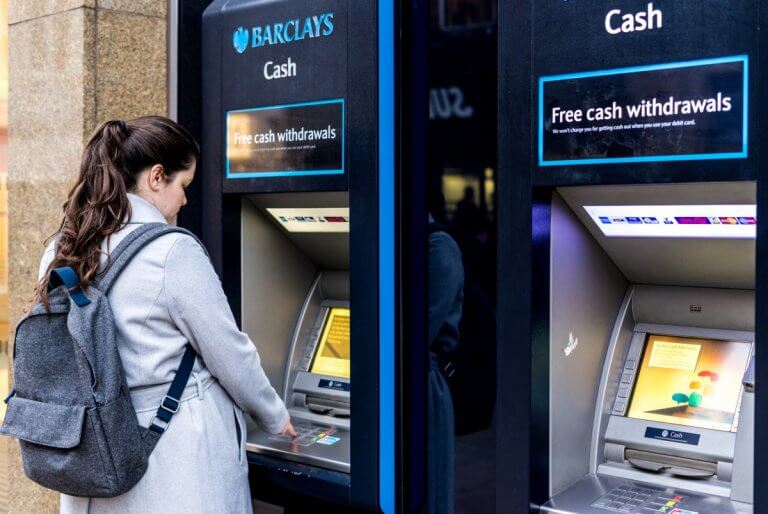
Your adventure in the UK is just beginning. You’re ready for cups of tea, scones with strawberries and cream, and pints at classically British pubs with new friends. Not to mention all your crazy elaborate plans to shoot off up and down the country exploring all that Britain has to offer.
Alas, to do all that you might need a penny or two, and to spend those pennies (we’re really hoping for your sake its pounds, not pennies you have) you will definitely need a bank account.
While you could use your account from home, you will almost definitely rack up a lot of charges for using your card abroad. Plus, life is much easier when you have a bank account in the country you’re living in and you’re able to view your funds in the currency you’re spending.

Your dollars are useless to me now – I work in pounds sterling only! Source: Giphy
Luckily, we’re here to talk you through setting up a bank account when you arrive in the UK on your Tier 4 student visa.
Choose which type of account you need
First things first, you need to pick a bank and account. It’s never too early to start looking, in fact, it is actually possible to start contacting banks as soon as your UCAS confirmation is through.
In the UK, the main banks are HSBC, Barclays, Lloyds, RBS, Natwest, Nationwide and Santander. Research each of these and see what they can offer you as, while they may appear similar on the surface, all are likely to have different interest rates, special offers and services.
You need to consider…
The location: You don’t want to pick a bank miles and miles away from your university accommodation. It might seem all well and good now but if you have to bus, train, cab or walk halfway across the city every time you need to cash a cheque or do any other kind of bank run, you won’t be so pleased.
It is free to take cash out from any ATM in the UK, not just your bank’s, but you never know when you might need to pop into the branch.
The cost of international transfers: You’re likely to want to send some money home and almost definitely will want to receive money from home. So, how much is your bank going to charge you for sending and receiving money from overseas? You’ll almost definitely want to look for one with the least expensive charge for international transfers.
https://twitter.com/prfrancesca/status/204998145241919488
The perks: Many banks offer freebies and incentives so it’s definitely worth checking out what you could get. Santander, for example offers a four-year railcard for discounted train journeys for students aged 16-25 with its 123 account.
Natwest and RBS offer similar incentives with a four-year Young Persons National Express card for discounts on coach journeys in the UK.
Overdraft: Can you get an overdraft and do you need one? As mentioned, often international students are not eligible for an overdraft facility but it is always worth an ask.
Remember, if you do get an overdraft, it is not an unlimited money pot and you will have to pay back the money you spend. Plus, if you hit the bottom of it, you really are stuck…you’d be owing money!
The type of account: There are lots of different kinds of bank accounts. Have a look online and see which one suits you best, however you are likely to want to just set up a standard ‘basic bank account’ from which you can pay money in, transfer money out or take it out from a cash machine and use your debit card in shops and online.
You might also be able to set up a savings account alongside this (in preparation for some travels around the UK perhaps on one of your snazzy new travel discount cards?).
An account like this is unlikely to give you credit so you will not be eligible for a credit card, cheque book or an overdraft.
There are, however, accounts specifically designed for international students which will give you much more flexibility than a basic account. Although, bear in mind, often these have stricter requirements such as needing to pay a monthly fee or retain a minimum balance.

Do I look like I’m made of money?! Source: Giphy
With international student accounts, however, you may get lots of added perks, including free international transfers or foreign cheque deposits.
You are still unlikely to be eligible for any credit on these accounts.
Sometimes your university may be able to suggest a certain bank or account for you and even offer assistance setting one up so be sure to ask student services at your institution if they provide such guidance.
How do you actually set one up?
Decided on everything? Great, now all you need to do is make an appointment at the nearest branch to your halls, house or flat. You can pop in if it really is that close or arrange it online or over the phone.
Bear in mind your appointment might not be for a few days or even weeks and even then it can take a little while longer for everything to go through so it’s not something you should expect to all happen overnight.
You don’t have to wait until term starts to set up your account either so once you’ve arrived in the UK it would be wise to put this near the top of your list of things to do. You will, however, need a permanent address to open an account so if you are staying with friends, family or in a hotel, hostel or AirBnB then you will need to wait until your new home is confirmed.

You’ll probably want to write a song about it too once you’ve finally set up your account. Source: Giphy
Don’t forget to bring all necessary documents with you when you go to your appointment.
You will need:
- Photographic ID (most likely, your passport)
- Your student visa
- Proof of address (a dated and addressed utility bill, a letter from your university’s admissions office confirming your address, or your tenancy agreement)
- UCAS confirmation letter
The exact documents required may vary from bank to bank so be sure to check the website carefully, give them a quick call or even pop into the branch if you’re close enough.
When you have your meeting, a representative will be there to talk you through it and help you fill in the application form.

We think you can probably manage that bit on your own. Source: Giphy
While you’re there, be sure to ask about online banking and mobile banking and see if you can get that all set up. It’s pretty handy to know how much is in your account without going to an ATM.
After that, you should be good to go. Keep your eye on the post as your card will come through in a letter from the bank a little while after your appointment. Your PIN number, used to access your funds, will come in a separate letter, usually a day or two after your card arrives.
Lastly, good luck. We hope you enjoy every last second (and penny) you spend in the UK!
Liked this? Then you’ll love…
UK Universities Minister aims to double number of students studying abroad







